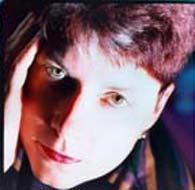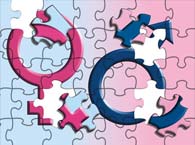Many people imagine that intersex people have two sets of genitals, but that is not the case. Cheryl Chase, founder and executive director of the Intersex Society of North America tells of her humiliating visits to the doctors' offices and her mission to end shame, secrecy and unwanted genital surgeries for intersex people.

Cheryl Chase is the founder and current Executive Director of the Intersex Society of North America whose mission is to improve the social and medical treatment of intersexed people. Born with an enlarged clitoris that doctors first thought might be a penis, baffled doctors had to figure out her sex for three days before telling her parents that they had a boy but not to breathe a word about their child's odd genitalia to anyone. A year and a half later, a specialist determined Chase had a uterus and ovaries and that she would be better off raised as a girl. Her clitoris was subsequently removed when she was 18 months old, and the family was told to get a new birth certificate, change her name and move to another city.
Chase was born with what doctors describe as "ambiguous genitalia" ("Doctors didn't know if they should call me a boy or a girl," she relates) which occurs far more often than some might think�in fact, some five babies per day, in the US alone, are born with ambiguous sex anatomy, according to Chase.
Because doctors have used the nineteenth century misnomer "hermaphroditism" many people imagine that intersex people have two sets of genitals. But that can't happen. "Ambiguous genitalia" refers to genitals with a clitoris larger than expected, or a penis smaller than expected. In other intersex conditions, the genitals may have normal appearance, but don't match the internal sex organs. For instance, a child might be born with female genitals and with internal testes.
Enduring the Unthinkable
When she was born in 1956, Chase's doctors did the unthinkable: they ignored the issue completely and kept her parents initially in the dark about her condition. In fact, Chase was raised as a boy until she was 18 months old, when her parents found their way to some doctors who considered themselves experts on intersex.
These doctors performed a clitorectomy, because "they thought that a woman's primary sexual role was to be passively penetrated," explains Chase. "A large clitoris would be a serious distraction."
This was followed by an endless series of exams and humiliating treatment at the hands of the medical community that lasted into her teens.
Though Chase was born in an especially repressed era�the lack of intersex education and power of sexual stigma was overwhelming�her questions finally overcame her fears. She demanded answers.
"I wanted to know why I had scars. I wanted my medical records. But I had a terrible time discovering my story," says Chase, who finally learned the facts of her medical history--at age 22. "It was incredibly shocking to me," says Chase. "My parents lied to me about it, and aunts and uncles also knew this, and this explained why they looked at me so funny�I was so paralyzed with shame."
Demanding�and discovering�the truth
Only at age 35 did Chase start to finally talk about her story with others. Slowly she found others with similar stories, which helped her grow in confidence and self-acceptance. "I realized it's relatively common," she says.

The 1-day INTERSEX Symposium will be held on May 1, 2006 in Istanbul, Turkey. The medical conference is organised by a group of Pediatric Endocrinology, Surgery and Urology experts at Istanbul University. More at http://www.intersex-tr.org.
But the road to enlightenment won't be without its rocks and bumps, says Chase. "The main reason for the doctors and parents discomfort when they have a baby whose sex anatomy isn't what they expect is they associate it with being queer," says Chase, "and with that sadly comes revulsion."
But progress is being made.
Demanding dignity and ending stigma
Chase says that the San Francisco Human Rights Commission, a body of citizens appointed by the mayor, spent much of 2004 investigating what happens to intersex babies in the medical system, recently issuing a 100-page report citing human rights violations.
"By exposing these human rights violations, and by educating parents before their child is born, we can help put an end to the medieval treatment of intersex children," says Chase.
"For the first time, intersex people have been recognized as human beings, who deserve to be treated by the same ethical principles as everyone else," says Chase. "No longer will we be subjected to sexually mutilating surgeries or have our medical records withheld from us or be lied to by our doctors."
Chase stresses that intersex children do need medical care, because often there are medical issues to be dealt with, including adrenal gland dysfunction or imbalance and (for some diagnoses) a higher risk of cancer of the testes.
"There are medical issues, but stigma is the most salient issue, and that is compounded with anxiety about gender identity and sexual orientation. The traditional medical response has been to try to cover it up, avoid these issues, through a combination of creative story-telling, medically unnecessary genital surgeries, and discouraging open discussion," says Chase.
"These children need to be referred to a specialist team, and we need to acknowledge that addressing the stigma associated with intersex conditions is a job for professional mental health people and peer support, not surgeons."











 Printable Version
Printable Version









